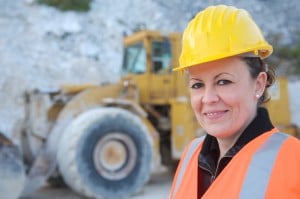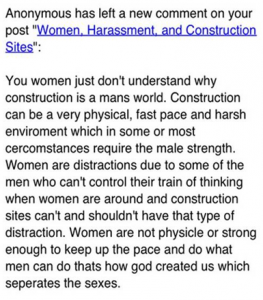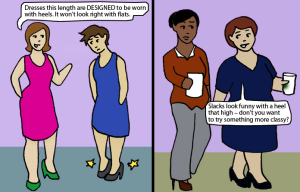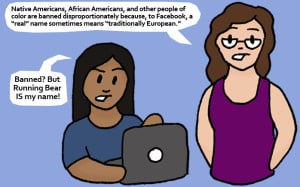
Source: Fensa Fitters
When we think about truck drivers, construction workers, garbage collectors, plumbers, electricians, and other blue-collar work, few of us immediately imagine women performing these tasks.
Women in non-traditional employment experience unique challenges that are exacerbated by working in fields where they are traditionally underrepresented and excluded, but they are also commonly overlooked in feminist discourses.
As an engineer, I understand the adversity women face in non-traditional, male-dominated workplaces. I have written about it extensively here, here, and here. And while I want women to enter any career type that they desire, I also want them to enter careers that pay well and put all of their skills to good use.
And I firmly believe that the real distinction between male- and female-dominated careers is the pay rate. Women earn less than men across the board, from the service industry to executive jobs. But the highest paying careers are still very male-dominated, from blue-collar work to STEM.
And this is not very surprising, as so-called “pink-collar” careers are not typically set aside for women because they require a special set of skills that only women possess – except for giving birth, which unfortunately doesn’t pay, in most cases – but rather, because they resemble traditional gender roles.
Skilled trades are often uncomfortable, dirty, dangerous, outdoorsy, hands-on, and overall non-girly. See what I did there?
But there are many women who want to (and do!) work in non-traditional trades, and their needs are just as important to my feminism as the pay gap and reproductive rights.
I include tradeswomen into my feminist (and especially STEM-specific) work because women in non-traditional employment go through similar hurdles that women in STEM do. The two fields are also closely related, especially for engineers, who work directly with personnel in active construction projects.
Women comprise of 47% of workers in all occupations, but are only 2.6% of construction workers, and that statistic hasn’t changed in the last 30 years.
I believe that promoting and uplifting women in trades should be a feminist priority because the myth of women’s inferiority actively hurts tradeswomen.
As feminists, it’s important to debunk myths that rely on strict gender roles because they are largely untrue and deeply problematic for the people who actively work in a non-traditional field.
Myths about women’s inferiority based on strength, work environment, and lack of comfort are simply untrue, and I’ll tell you why.
Myth #1: Women don’t have the physical strength required to work in construction or other male-dominated blue collar work.
Physical strength is quite subjective, but the first thing that I hear from those who oppose having more women in construction and blue-collar work is that women are not capable of physically demanding jobs, as demonstrated in this comment that I received on an article that I wrote:
Physical strength is generally not a biological fact. We raise boys to learn that strength matters and that they need to be physically active and fit, while girls are encouraged to be dainty and frail. This isn’t always the case, as many girls do play sports and are involved in many active pastimes, but it’s a common misconception.
Strength is a social construct, not a biological fact.
Strength is important, and most men do have more lean muscle than women, but that alone won’t make a person capable of lifting heavy objects, or you know, using a hammer.
I’ll use an example of a traditionally male job: firefighters. Many states have separate requirements for how much weight an individual needs to be able to lift, which is generally an average weight for an adult, about 150-200 pounds. And when women are subjected to these tests, they fail at higher rates than men.
So, we can dismiss women as physically inferior, or we can help individuals learn how to carry heavy objects based on their body type.Lifting for men is easier when they use their upper body strength, which is where most women are lacking. This uses men’s strength to their best advantage.
But if you let women determine how best to carry large weights, you notice that they tailor the movement to their strengths, by putting most of the weight and load on their hips and then on to their shoulders. It’s a simple adjustment, but it helps us do the same jobs while being safe.
Myth #2: Construction sites are dirty and uncomfortable, and women don’t like that type of work.
I’m not quite sure why this is supposedly an issue that only pertain to women. I know many men who absolutely hate working outdoors in a dusty and hot job site, and I know women who love it.
This preconceived notion is based on the false idea that women are vain and only care about their looks.
If that were the case, women wouldn’t be nurses in such large numbers, dealing with sick patients and wearing scrubs all day. But they do! They also would never become mothers because there is absolutely nothing clean about having or raising children.
It’s an odd myth, but the idea that women don’t like to or shouldn’t get dirty is rooted in women being taught that they must visually please men.
And while there is nothing wrong with genuinely disliking working outdoors in the heat, dust, or snow, it’s simply untrue that this is accurate for an entire gender – and, moreover, not another.
If the sight of a little dirt or sawdust on a woman in not pleasing, then don’t look at her. That was simple. (See? Women are good at problem-solving, too.)
In the end, if the job gets done, that’s what truly matters. How we look while doing so becomes pointless when we realize that physical labor is sweaty and hot, and it doesn’t discriminate based on gender.
Myth #3: Women will want special treatment if they work in non-traditional jobs.
Many women in non-traditional employment complain that they are not provided with female bathrooms, personal protective equipment that fits properly, and must perform their work in hostile and intimidating environments.
Perhaps some might call this “special” treatment, but no one should have to feel that their workplace is unsafe and unwelcoming.
Discriminatory behavior has consequences, as in the case of a contractor that did not have restrooms for their female employees, forcing them to relieve themselves outdoors. The female employees of this company were also sexually harassed, intimidated, and pressured to go on dates with male employees.
The victims sued and were monetarily compensated, but what does that say about the culture women endure in jobsites? Treating female employees the same way you treat male employees is not special treatment. In fact, it seems that some go out of their way to treat women differently, though not rightfully.
Female employees also complain of ill-fitting personal protective equipment (PPE), which is a hazard for women on jobsites that can be easily fixed.
Ill-fitting reflective vests can be uncomfortable at best or deadly at worst. Vests that are too large and baggy can get caught in machinery with moving parts exposing the worker to injury. For women who work near train tracks, baggy vests can be a deadly hazard if it gets caught on moving train parts or electrical equipment.
Providing protective equipment that fits all body types is a necessity, and it benefits everyone on a jobsite.
Being treated like a human being with needs that might differ from male needs is not special treatment. It’s cooperative, and it’s the law.
Myth #4: Women don’t contribute anything different to the job site.
Except that they do.
I have written about the importance of a diverse workplace before and how it truly does create a better working experience for all, particularly those in need of a relatable mentor.
And this is categorically true across all industries and careers.
Women always find that they must defend their place in society and the workplace.
Somehow everything that we want to do is already taken up by the male half of the species, and this is sold as “just the way things are” as opposed to years of discriminatory policies and rampant sexism.
The problem here is that I really want to explain how it is that women can contribute to blue-collar work, but what I say won’t matter if we assume that women are physically and intellectually inferior in the first place.
Yet the truth is that it’s not just about what women can contribute to a job site, but what we can get from such a job.
Some of us like fast-paced and ever-changing tasks that allow us to multitask and be active, and if we are not treated with dignity and respect while performing these tasks, we have every right to voice that.
The real question is: Why does that bother some people? (See picture below. I get the nicest comments!)
***
In the midst of all the sexist and sometimes racist remarks that women must put up with just to perform their job, it isn’t surprising that so many of us want to give up or look at other career options.
But it’s not that women just don’t like working in blue-collar jobs. It’s that we are routinely pushed away from tasks that allow us to use these skills.
Every day, we are bombarded with images that drill into our minds the idea that we simply are not meant for these jobs, such as this Snickers commercial that suggests real men are sexual harassers by using the sexist construction worker trope.
We shouldn’t have to fight for the same respect and consideration men get, yet here I am.
But there is positive change coming.
Earlier this year, the President rolled out the American Apprenticeship Initiative that will provide grants for people seeking to do apprenticeships in skilled trades.
More specific to women, there is also the Women in Apprenticeship and Nontraditional Occupations Program (WANTO), which is the only federal grant program the specifically trains women to work in non-traditional fields. Unfortunately, this program will not be receiving any grants for the year 2015, further showcasing how neglected women who wish to enter these fields are.
Passing the Women WIN Jobs Act will help support women in non-traditional employment, but has received little support from our congress.
For the few women who even attempt to enter non-traditional blue-collar work, few make it out of training. As some have to invest money to receive training, this can become a financial burden on top of the emotional stress of working in a place where you are unwanted and unsupported.
Yet organizations such as Nontraditional Employment for Women, Real Women in Trucking, The Hammerstone School, and Oregon Tradeswomen, Inc. (among many others) are training women, providing mentorship, and just lending an ear when needed.
There is a lot of support for women to pursue powerful careers (see: Lean In) and I think that is needed and necessary, but my feminism does not forget that women’s equality means supporting women in all their choices.
Not many of us dream of being a carpenter, ironworker, or electrician, and that’s because we think we can’t perform these tasks, but I’m here to tell you that we can and we do!
[do_widget id=”text-101″]
Patricia Valoy is a Contributing Writer for Everyday Feminism. She is a Civil Engineer, feminist blogger, and STEM activist living in New York City. She writes about feminist and STEM issues from the perspective of a Latina and a woman in engineering. You can read more of her writings on her blog Womanisms, or follow her on Twitter @besito86. Read her articles here and book her for speaking engagements here.
Search our 3000+ articles!
Read our articles about:
Our online racial justice training
Used by hundreds of universities, non-profits, and businesses.
Click to learn more






















